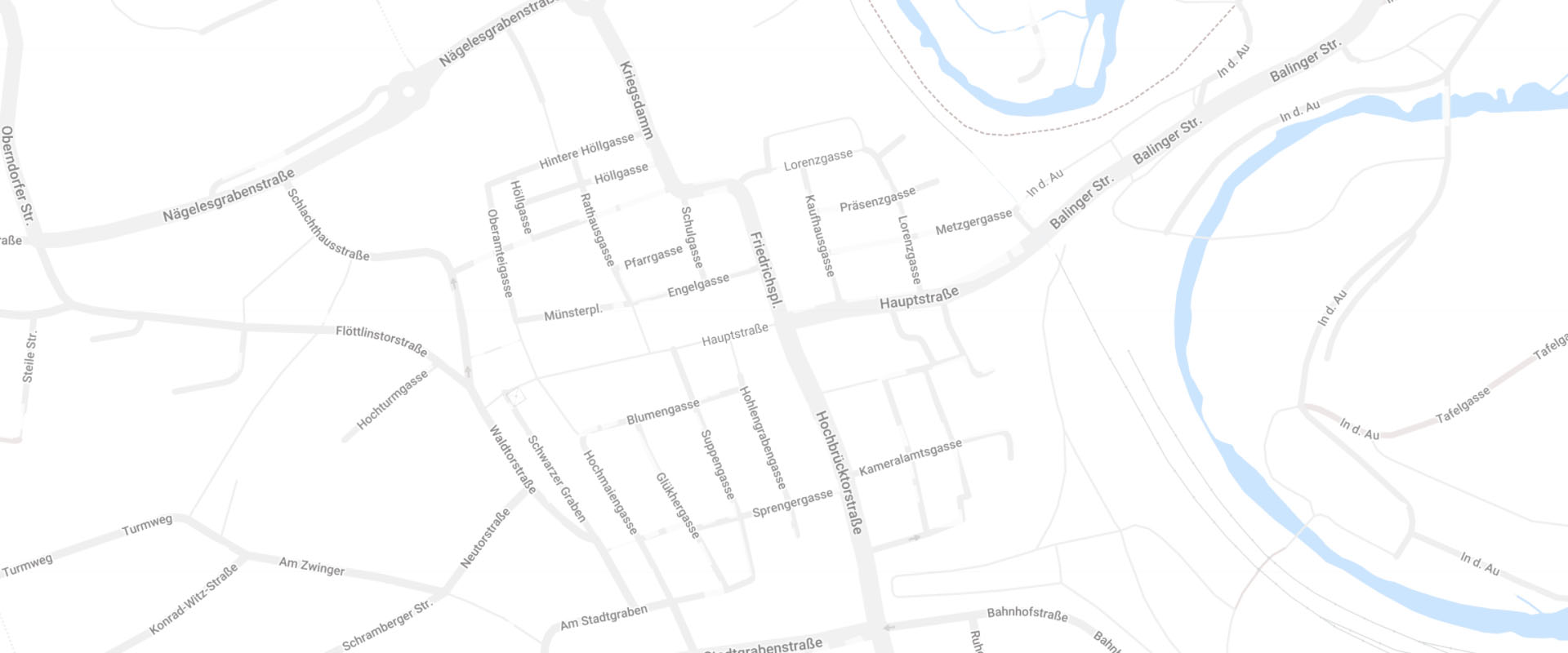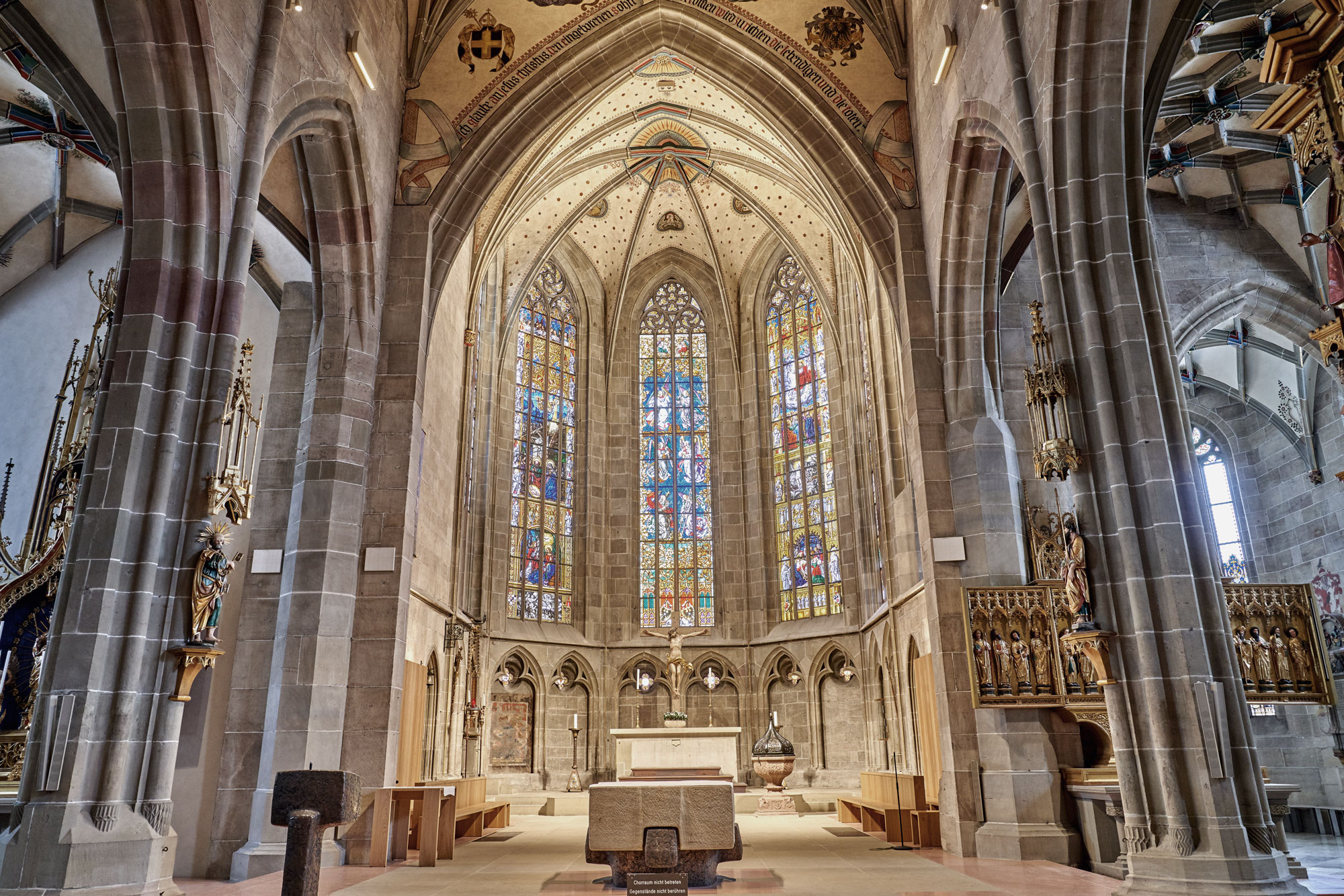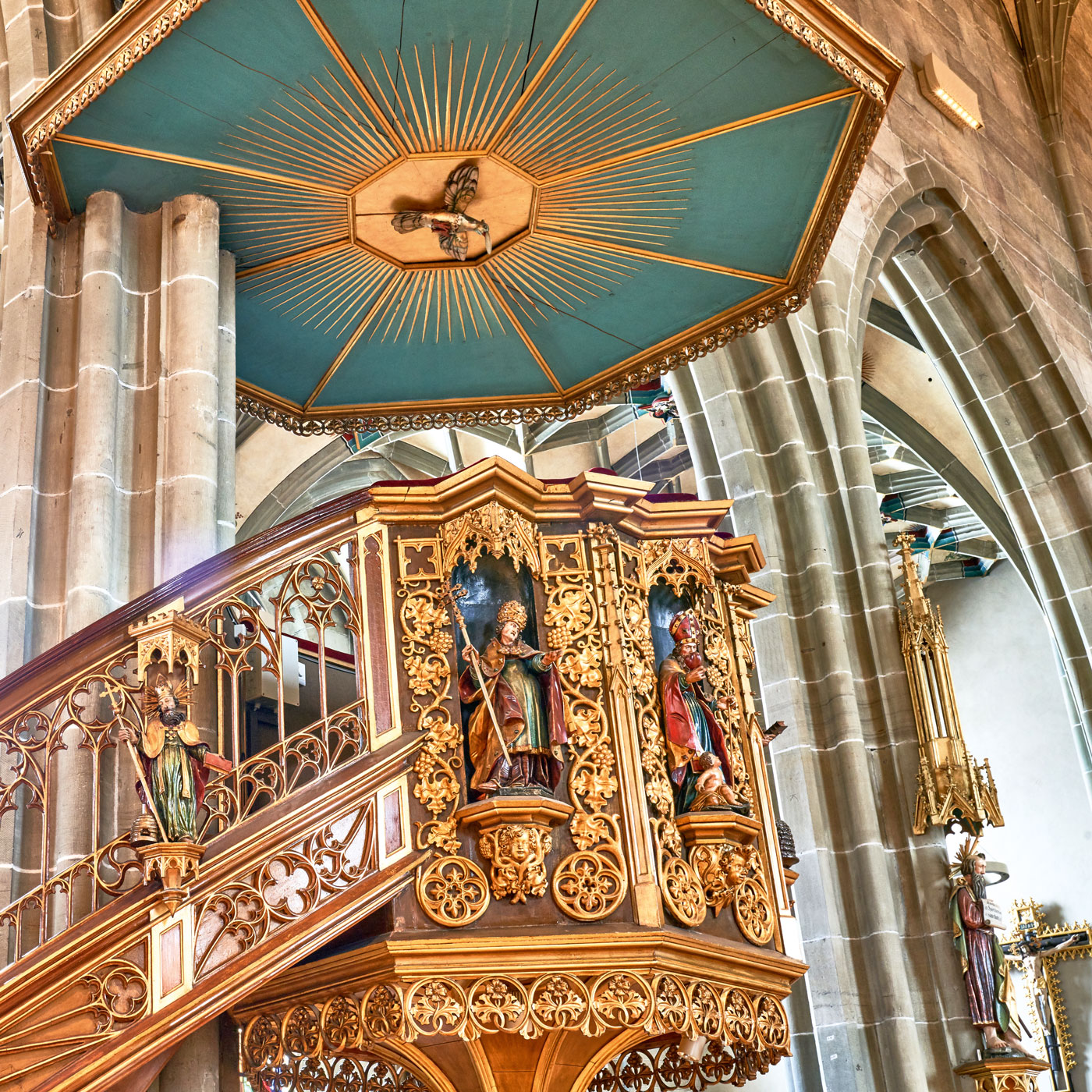3. Heilig-Kreuz-Münster
Catholic parish church, originally late Romanesque basilica, refurbished in Gothic style in 15th/16th century.
Read the story
“Heilig Kreuz” or “Holy Cross”, Rottweil’s main Catholic church, which was elevated to the status of a Minster in 1950, stands in a prominent position on a wide, quiet square. Trees provide shade, and opposite the main portal there’s a fountain splashing water. Until about 1570, the graveyard used to be here. And where the benches stand today, framed by a modest wall, there used to be an ossuary where the bones of the dead were piled up after a certain length of time in graves.
The origins of “Heilig Kreuz” date back to the year 1122, when a Romanesque church stood on this site and it is here that Bernard of Clairvaux was believed to have sermonised on the crusade to the Holy Land. 100 years later, the three-nave “Heilig-Kreuz-Kirche” in late Romanesque style was erected. What is now left are the three lower floors of the tower with its arched gate and Romanesque friezes as well as two early Gothic arches in the central nave of the tower and the Romanesque west portal. In 1400, the characteristic high Gothic choir towering the nave was added. The nave, a late Gothic stepped hall with typical Swabian buttresses, was only completed in the 16th century.
Take a closer look at the south nave with its key and bracket stones and the baptistry. What strikes the eye here is a beautiful girl’s head with blonde hair and a huge goitre – in the late Middle Ages the symbol of sexual desire and hedonism. A late medieval saying goes like this: “A horny head rests on a full goitre”. Even the devil comes into play here, as misshapen figures were associated with the devil.
In keeping with the spirit of the times, the church was embellished in baroque style after the Thirty Years’ War.
In the great fire of 1696, “Heilig Kreuz” was also severely damaged. While the tower was burning, the bells were melting and falling down, the entire roof truss was on fire. In the hasty reconstruction of the tower, people used wood with varying amounts of residual moisture. Looking up at the spire today you will recognize the lopsided construction with a deviation of about 1.30 metres from the centre. In the course of the latest renovation in 2017 it would have been possible to re-align the tower hood. But the leaning tower has become a characteristic element of the townscape.
Already in 1697, five new bells were cast, of which the biggest one, the “Dreifaltigkeitsglocke” or “trinity bell”, has survived and is rung every day. The broadest part of bell has a diameter of 163 cm and weighs 2.8 tons.
What’s more, in 1700 the church received new pews with inventive designs at each end. No two motifs are alike. The rich variety of reliefs include the fools’ mother, a character of the Swabian carnival, flowers, animals, coats of arms and saints. An Easter Bunny was added at a later stage. The baroque pulpit supported by a lion is also worth seeing.
In 1840, “Heilig Kreuz” was thoroughly gothicised. The architect responsible was none other than the old master of historicism, Carl Alexander Heideloff. He was awarded the title of a Royal Conservator by the Bavarian King Ludwig I. The construction of the fairy-tale castle Lichtenstein near Reutlingen was based on his plans. Carl Alexander Heideloff had the baroque interior of the church removed; then he scoured the art market for high-quality sacred art from the Gothic and Renaissance period. The colourful choir windows that Heideloff ordered from Nuremberg porcelain painters date from this time and depict the life of Christ impressively. The crucifix above the altar, dating back to 1515, had long been attributed to Veit Stoß; and, presumably, it must have been created in his circle.
The rear southern side chapel, the “Nepomuks-Kapelle”, is the spot where the Rottweil guilds store their lanterns. On major holidays like Ascension Day and Corpus Christi, they are still carried through the town in solemn processions, and also once a month in a procession in the church, during a small devotional service.
In 2017, the church was thoroughly restored. Centuries-old soot on altars, walls and ceilings was removed. Now light is mirrored again in the gold, and art lovers will delight in viewing all the figures, coats of arms, grotesque faces and saints. It’s best you bring your opera glasses to get a good look.
Location

Mit dem Laden der Karte willigen Sie in den damit verbundenen Datentransfer zu Google ein.
Mehr erfahren
Information
You want to know more?
In our tourist information office we will gladly tell you more about our many guided tours:
Tourist-Information Rottweil
Hauptstraße 21
78628 Rottweil
Tel: +49 741 494 280
E-Mail: tourist-information@rottweil.de
360°-Panorama


South side of the „Heilig-Kreuz-Münster“

View of the choir

The pulpit in the „Heilig-Kreuz-Münster”
Read the story
“Heilig Kreuz” or “Holy Cross”, Rottweil’s main Catholic church, which was elevated to the status of a Minster in 1950, stands in a prominent position on a wide, quiet square. Trees provide shade, and opposite the main portal there’s a fountain splashing water. Until about 1570, the graveyard used to be here. And where the benches stand today, framed by a modest wall, there used to be an ossuary where the bones of the dead were piled up after a certain length of time in graves.
The origins of “Heilig Kreuz” date back to the year 1122, when a Romanesque church stood on this site and it is here that Bernard of Clairvaux was believed to have sermonised on the crusade to the Holy Land. 100 years later, the three-nave “Heilig-Kreuz-Kirche” in late Romanesque style was erected. What is now left are the three lower floors of the tower with its arched gate and Romanesque friezes as well as two early Gothic arches in the central nave of the tower and the Romanesque west portal. In 1400, the characteristic high Gothic choir towering the nave was added. The nave, a late Gothic stepped hall with typical Swabian buttresses, was only completed in the 16th century.
Take a closer look at the south nave with its key and bracket stones and the baptistry. What strikes the eye here is a beautiful girl’s head with blonde hair and a huge goitre – in the late Middle Ages the symbol of sexual desire and hedonism. A late medieval saying goes like this: “A horny head rests on a full goitre”. Even the devil comes into play here, as misshapen figures were associated with the devil.
In keeping with the spirit of the times, the church was embellished in baroque style after the Thirty Years’ War.
In the great fire of 1696, “Heilig Kreuz” was also severely damaged. While the tower was burning, the bells were melting and falling down, the entire roof truss was on fire. In the hasty reconstruction of the tower, people used wood with varying amounts of residual moisture. Looking up at the spire today you will recognize the lopsided construction with a deviation of about 1.30 metres from the centre. In the course of the latest renovation in 2017 it would have been possible to re-align the tower hood. But the leaning tower has become a characteristic element of the townscape.
Already in 1697, five new bells were cast, of which the biggest one, the “Dreifaltigkeitsglocke” or “trinity bell”, has survived and is rung every day. The broadest part of bell has a diameter of 163 cm and weighs 2.8 tons.
What’s more, in 1700 the church received new pews with inventive designs at each end. No two motifs are alike. The rich variety of reliefs include the fools’ mother, a character of the Swabian carnival, flowers, animals, coats of arms and saints. An Easter Bunny was added at a later stage. The baroque pulpit supported by a lion is also worth seeing.
In 1840, “Heilig Kreuz” was thoroughly gothicised. The architect responsible was none other than the old master of historicism, Carl Alexander Heideloff. He was awarded the title of a Royal Conservator by the Bavarian King Ludwig I. The construction of the fairy-tale castle Lichtenstein near Reutlingen was based on his plans. Carl Alexander Heideloff had the baroque interior of the church removed; then he scoured the art market for high-quality sacred art from the Gothic and Renaissance period. The colourful choir windows that Heideloff ordered from Nuremberg porcelain painters date from this time and depict the life of Christ impressively. The crucifix above the altar, dating back to 1515, had long been attributed to Veit Stoß; and, presumably, it must have been created in his circle.
The rear southern side chapel, the “Nepomuks-Kapelle”, is the spot where the Rottweil guilds store their lanterns. On major holidays like Ascension Day and Corpus Christi, they are still carried through the town in solemn processions, and also once a month in a procession in the church, during a small devotional service.
In 2017, the church was thoroughly restored. Centuries-old soot on altars, walls and ceilings was removed. Now light is mirrored again in the gold, and art lovers will delight in viewing all the figures, coats of arms, grotesque faces and saints. It’s best you bring your opera glasses to get a good look.
Location

Mit dem Laden der Karte willigen Sie in den damit verbundenen Datentransfer zu Google ein.
Mehr erfahren
Information
You want to know more?
In our tourist information office we will gladly tell you more about our many guided tours:
Tourist-Information Rottweil
Hauptstraße 21
78628 Rottweil
Tel: +49 741 494 280
E-Mail: tourist-information@rottweil.de
360°-Panorama


South side of the „Heilig-Kreuz-Münster“

View of the choir

The pulpit in the „Heilig-Kreuz-Münster”



